Tow Your Tiny House
Find out how to safely tow your tiny house!
Find out how to safely tow your tiny house!
What are portable luxury restrooms and where are they going?
The Americans with Disabilities Act and its importance in design
A thief would have to be pretty determined to steal a whole house. A tiny house on wheels is a highly visible item and most are custom-built, making it an easily recognizable theft. It’s not the type of thing a thief can slip away with in the night and sell on the internet, never to be seen again. There are only so many places on the internet to sell one, all of which can be monitored to see when the house comes up for sale. Additionally, to transport a tiny house, one can take it on certain roads, but it has to have a license plate, and any tiny house owner can attest that tiny houses on the road generate a lot of buzz.
However, two recent thefts of tiny houses have popped up in the news, reminding us that while rare, it can happen. On that note, it’s important to find a way to secure one’s tiny house and prevent or at least deter thieves from breaking in or stealing it.
The best course of action to ensure your house’s security is having multiple theft deterrents. The idea of theft deterrence is realizing you can’t do everything possible to ensure your house will never get broken into or stolen altogether, but there are many small things you can do to discourage criminal activity. Many thefts are crimes of opportunity: if you make it a difficult and time-consuming for a thief to quietly drive away with your house in tow, they are more likely to pass your tiny house up.
Just a note: we’ve included links to certain products in this article. We aren’t being compensated for posting any of these products and we don’t necessarily recommend or guarantee these exact products: the links are here so you can get a feel for what they are and how they work.
 Trailer Hitch Lock:
Trailer Hitch Lock:A hitch lock is an easy, quick theft detterent. It can be cut off, but not without spending some time and creating some noise. This will at least slow down a potential house thief, and some have the added benefit of preventing runaway trailers.
There are numerous types of trailer hitch locks, ranging in price from about $17-$45. Here’s a list of reviewed trailer hitch locks from thetoppro.com.
 Wheel Lock:
Wheel Lock:These work in many different ways, but the one pictured here covers the wheel, rendering it immobile. You can also purchase locks for the lug nuts themselves. Here’s a list of wheel locks from etrailer.com: they range in price from under $10 to $180.
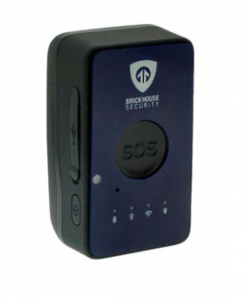 God forbid someone actually gets away with your tiny house, it would be easy to track if you have one of these in or on your tiny house. Hundreds of discreet GPS trackers are on the internet, and many are inexpensive enough to make the purchase worth the peace of mind you’d get from having one. The tracker pictured here, from Brickhouse Security (here are their best GPS trackers), is less than 2″ x 3″, so you can place it inconspicuously so a thief doesn’t know it’s there. You can track its location on your phone or computer.
God forbid someone actually gets away with your tiny house, it would be easy to track if you have one of these in or on your tiny house. Hundreds of discreet GPS trackers are on the internet, and many are inexpensive enough to make the purchase worth the peace of mind you’d get from having one. The tracker pictured here, from Brickhouse Security (here are their best GPS trackers), is less than 2″ x 3″, so you can place it inconspicuously so a thief doesn’t know it’s there. You can track its location on your phone or computer.
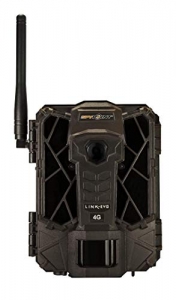
As the economy forces package thieves to become bolder and bolder, the market for home security has exploded, and security cameras are getting cheaper every year. Even if your security camera doesn’t prevent the most determined thief, it is certainly a theft deterrent. Some security cameras use motion detection to start recording a ten-second video; others record all the time.

Security cameras that store the images and/or video inside them are only helpful after you recover the camera itself. A smarter choice is either a wifi-connected home security camera like Arlo or Nest, or a trail cam, which operates on cell data (you’ll have to pay monthly). Both a wifi-connected cam (here are PC Mag’s top picks for 2019) or a trail cam (here are Trail Cameras’ Reviews for 2018) allow you to see the images in near-real-time on your phone or computer.
 If a security camera isn’t enough, you can have a whole integrated security system in your tiny house, as long as your house gets constant power. Smart home security systems like Honeywell’s allows you to choose a la carte what features you’ll use, such as notifications when windows or doors are opened, motion light activation, facial recognition of those entering your house, and voice control with Amazon Alexa.
If a security camera isn’t enough, you can have a whole integrated security system in your tiny house, as long as your house gets constant power. Smart home security systems like Honeywell’s allows you to choose a la carte what features you’ll use, such as notifications when windows or doors are opened, motion light activation, facial recognition of those entering your house, and voice control with Amazon Alexa.
(Full disclosure– Honeywell’s not paying us to post this, but we did build a tiny house for them integrating their smart home tech, so we’re familiar with their technology and we like their brand).
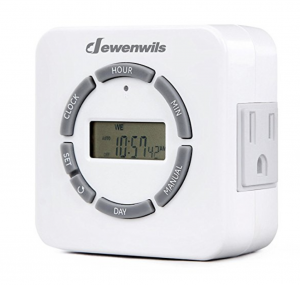

These lights are great for when you’re not at home but want to give the impression that someone is there.
The simplest and cheapest option is a light timer, which can either be plugged into a wall socket (this one’s by Dewenwills, pictured at left) or integrated into the light switch plate (this one’s by Honeywell, pictured at right). It turns a lamp or electric outlet on and off at a specific time or times every day. The mechanical ones make a clicking sound that will drive you nuts in a small space, so we recommend an electronic light timer.

Most people have been familiar with motion sensor lights for decades. Not only can they be a theft deterrent by attracting attention to the house when there’s movement, they can also increase the security of the tiny house dweller when coming home and fumbling for keys in the dark. Here’s The Spruce’s list of best motion sensor lights for different outdoor areas. Some of these contain the sensor within the bulb, so the bulb can be screwed directly into any light socket, which means you won’t have to do any wiring to make them work. Some of the lights on this list run on their own solar power which is nice for when your tiny house isn’t connected to a power system.
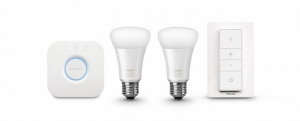
Like timed lights, remote controlled lights help create the illusion that someone’s home, but they’re a bit “smarter” in terms of going on either when they sense motion or when you decide to activate them from afar via your electronic device. Remote-controlled smart lights, for when you’re far away to your wifi-connected tiny house, allow you to turn on a light in your home via an app on your phone. Here are a couple ways to integrate smart lights from Make Use Of, whether your house hasn’t been built yet and you can install these during the building process, or you’d like to install plug-and-play smart lights in your exisiting tiny house. You can also get remote control of the lights in your tiny house by incorporating them into your existing smart home security system.
 This one’s pretty simple: although not all tiny house owners are parked near neighbors, those who are and have a friendly rapport with them can ask their neighbors to keep an eye on their tiny house. Having possible witnesses close by is a major deterrent to break-ins and thefts.
This one’s pretty simple: although not all tiny house owners are parked near neighbors, those who are and have a friendly rapport with them can ask their neighbors to keep an eye on their tiny house. Having possible witnesses close by is a major deterrent to break-ins and thefts.
(Pictured: The Hoosic Tiny House flanked by two other tiny houses. Photo by Try It Tiny)
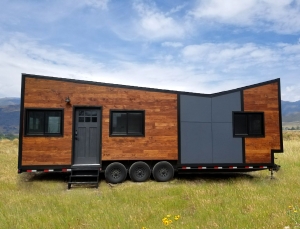 When choosing a location for your tiny house, from a theft deterrent standpoint, consider how easy it is for someone to get away with your tiny house. Anyone who’s ever towed a tiny can attest that tiny houses attract a lot of attention on the road. People peer out of their windows, take photos, post them on the internet. Whether you want to attract attention or not, it’s like being in a single-float parade.
When choosing a location for your tiny house, from a theft deterrent standpoint, consider how easy it is for someone to get away with your tiny house. Anyone who’s ever towed a tiny can attest that tiny houses attract a lot of attention on the road. People peer out of their windows, take photos, post them on the internet. Whether you want to attract attention or not, it’s like being in a single-float parade.
Likewise, if your tiny house is easily recognizable, it’s more easily recovered. An unusual looking tiny house can’t go as far and long without being reported.
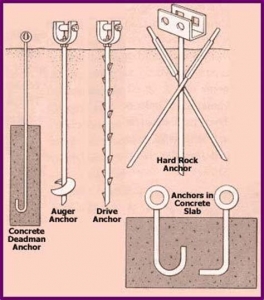 For those who do not travel with their tiny house, tie-downs aren’t just a good idea for theft deterrence. They’re also a great idea to keep the house from rocking or even lifting during a hurricane. Although one can remove the house from the anchors (with varying degrees of difficulty depending on which type of anchor you’re using), this takes time and is another way to deter theft.
For those who do not travel with their tiny house, tie-downs aren’t just a good idea for theft deterrence. They’re also a great idea to keep the house from rocking or even lifting during a hurricane. Although one can remove the house from the anchors (with varying degrees of difficulty depending on which type of anchor you’re using), this takes time and is another way to deter theft.
Additionally, building a porch onto the front of your tiny house not only expands your livable space in nice weather and creates a more welcoming entrance, it makes it more difficult for a thief to quickly steal your tiny house.
 Like anchoring with tie-down straps, it’s not impossible to remove a septic or sewer tie-in, but it takes longer, requires tools and knowledge which means it takes longer to steal someone’s house. Of course, not all tiny houses stay in one location– they are on wheels, after all– but for those that do, this is a great option.
Like anchoring with tie-down straps, it’s not impossible to remove a septic or sewer tie-in, but it takes longer, requires tools and knowledge which means it takes longer to steal someone’s house. Of course, not all tiny houses stay in one location– they are on wheels, after all– but for those that do, this is a great option.
Image from My Camper Home on Youtube
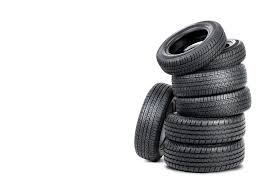 When the tires are removed, a thief can’t just hook up a tiny house to their truck and roll away with it. It takes time and tools to attach four or six tires to the wheels of a trailer: time that exposes a thief to witnesses.
When the tires are removed, a thief can’t just hook up a tiny house to their truck and roll away with it. It takes time and tools to attach four or six tires to the wheels of a trailer: time that exposes a thief to witnesses.
This is a question we get almost every day. Often, your town won’t have already considered whether to allow tiny houses as year-round residences: it just takes someone to ask.
Start out by looking at the zoning laws in your own town. B&B Tiny Houses are built to RVIA standards, which legally classifies them as RVs. If your town or city doesn’t allow RVs, then you can either ask your planning board or go to another town.
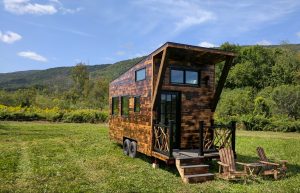
Networking is a common way people find spaces for their tiny houses: start out on Facebook, Meetup, or in person at a tiny house festival. By using personal networking rather than tiny house websites, you might find someone with land willing to rent a space to you who hasn’t previously heard about tiny houses or considered renting a small piece of their land for one. Try Facebook Groups that are tiny house specific, or just general community groups. Before agreeing to rent someone’s land, though, make sure both you and the potential landlord are aware of the tiny house legalities in that community.
Search Tiny House Villages: RV Parks, villages, and communities across the United States and Canada that allow tiny houses.
Try It Tiny: Short-term and long-term rental lots, often on privately owned property, for your tiny house as well as tiny houses for rent.
This list was updated in April 2019 by adding new groups, deleting now-defunct groups, and improving formatting. Did we miss anything? Let us know via email: [email protected].
I work in a tiny house. More specifically, a mobile office. Here at B&B, our company has grown faster than our factory has, so now a few of us share the 8 1/2′ x 20′ Brodie Mobile Office for 8 hours a day, 5 days a week. During that time, I’ve learned quite a few things about how to best design a small space for maximum working and living.
Here’s what I’ve learned:
 Windows and skylights make a huge difference.
Windows and skylights make a huge difference.Before moving out to the mobile office, I was working inside the factory in a little room we built into the corner of the warehouse. This room had windows to the factory but no windows to the outside. Now that I’m in the mobile office and my desk faces two windows, my quality of life has really improved. The old office, although it was bigger than the mobile office, felt a bit cave-like, and not in the way of grand echoing caverns; it was more like those tiny spaces spelunkers narrated by David Attenborough have to squeeze their bodies into. Anyhow, with its tall ceilings, skylights, and windows all around, the tiny mobile office, although smaller than the old office, feels way more spacious.
Both for air exchange and light, it’s nice to have windows on all sides of you. Opening a window at either side of the house creates a nice breeze. Because you’re surrounded by windows rather than looking at one or two walls with windows, the space feels more expansive and airy than a smaller space.
This goes for any house, not just tiny houses, but it’s something I’ve learned from this particular tiny house so I thought I’d share it here. I can’t stress this enough: choose a floor color that’s not going to show every single piece of dirt, dust, sand, mud, piece of grass, and microscopic pebble. This house was photographed on a day when the snow went up to our knees and we mopped the floor just before the shoot. If we hadn’t, you’d see all kinds of smudges on it.
The absolute best floor for mud-concealment is this grey one with lots of color variation. This house (the Arcadia Tiny House) has been exhibited on rainy, muddy days with hundreds of people (and double that number of boots!) walking through and you couldn’t even tell it was dirty.

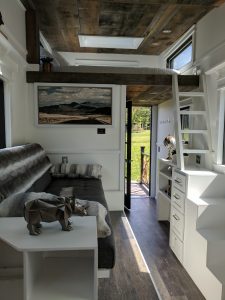
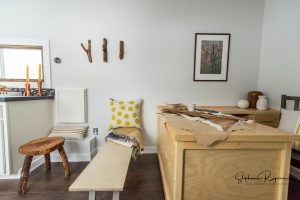 Mobile offices are great for greeting customers outside the work area.
Mobile offices are great for greeting customers outside the work area.Our workshop has six tiny houses being built at a time, with houses, trucks, deliveries, forklifts, et cetera rolling in and out of our factory doors all day. We don’t generally like to invite visitors inside this active work environment simply because it’s too much of a liability. Having the mobile office outside as the face of our company allows us to greet customers in a safe environment, free of sawdust, noise and hazards.
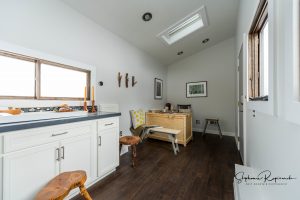 More people can fit in an 8 1/2′ x 20′ space than you think without feeling claustrophobic.
More people can fit in an 8 1/2′ x 20′ space than you think without feeling claustrophobic.We’ve had non-claustrophobic meetings with ten people inside. The level of claustrophobia definitely depends on the amount of stuff inside the house. Since this is an office, not a home, and most of our files are digital, not on paper, we really don’t need that much stuff inside the mobile office. We keep architectural samples, like color chips, siding swatches, and stain samples, but other than that pretty much everything’s digital.
Additionally, the objects that we do have are stored inside the cabinetry so they don’t add to visual clutter.
It’s quiet in the mobile office. Really quiet. It’s a side effect of being well-insulated. So during mealtimes it can be a bit… overwhelming for someone who doesn’t like to hear others chewing. My favorite white noise generator is Celestial White Noise on YouTube. Ten hours of a gentle hum that you tune out after a minute and don’t have to hear every time your coworker shifts in their chair.
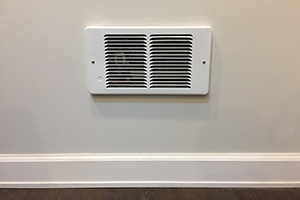
I have hot soup for lunch all the time in the winter. To make sure the mobile office doesn’t then smell like soup for the rest of the day, I always open the restroom door and turn the extractor fan on after eating a hot lunch. It only takes a couple minutes to return the air in the house to freshness.
Certain heating and cooling systems also include air exchange (ours doesn’t)– I’d recommend getting that if possible.
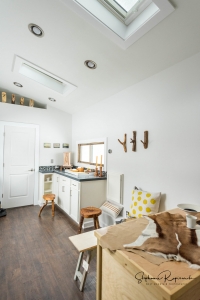 Tall ceilings and not too much clutter on the walls really make a space feel bigger.
Tall ceilings and not too much clutter on the walls really make a space feel bigger.Perhaps this goes without saying, but I think it’s worth mentioning the tall ceilings inside this tiny mobile office. In order to be road-legal, the tiny house has to be under 13 1/2′ tall so it can fit under bridges, trees and power lines. With the inside floor being just over 2′ off the road, there is still room for a taller-than-usual ceiling inside– and it makes a huge difference!
Tiny houses have risen in popularity over the years, and there’s a good reason for this: tiny houses offer many perks that will appeal to almost anyone. Tiny houses are economical, sustainable, and can even be a great investment or supplementary source of income.
We’ve had baby boomers choose the tiny house lifestyle for a multitude of reasons. Some want a big change in their life, want a simpler life, or want to travel more. Also, we have had baby boomers choose to live in a tiny house and rent out their traditional house for additional income.
With educational loans and rent costs rising, many millennials are delaying buying a house–only 20 percent of millennials have a mortgage. In addition, many millennials find the pros of living more sustainable and minimalistic very desirable. Tiny houses allow millennials to put money that would otherwise be going down the drain towards an investment that they can get back.
If you’re looking for a change in your life and yearn to get away from all hecticness that overconsumption can bring, the tiny house lifestyle may be the solution you’ve been seeking. The minimalistic lifestyle is about owning the perfect amount and focusing on your needs and talents in order to become the happiest version of yourself. Because space is a commodity in a tiny house, it makes you to only keep and buy what will add value to your life. Read more about minimalism here.
On and off-grid options allow tiny house owners to reduce their carbon footprint–a net zero carbon footprint is possible in off-grid living. Tiny houses require less materials to build and use significantly less water, heating, and cooling because of their size. In addition, their size limits the amount of waste produced. Check out these two blogs to learn more about simple living and off-grid living.
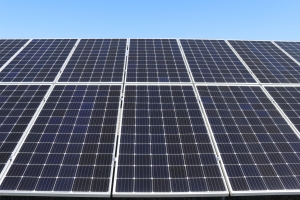
Families that decide to go tiny may use the house for vacations or live in it full time. Although living with your family in a tiny house will undeniably bring its own challenges, the benefits of living in a tiny house are immeasurable. Teaching your kids about the importance of memories and family are just a few! Read about this five person family that decided to go tiny full time.
Families with aging parents or those that want to provide their older children with special needs an increased sense of independence can turn to tiny houses. Nursing homes cost an average of $235 daily for a shared room, which is a hefty sum for most families. Our tiny houses can be built to ADA standards and are a much cheaper option. Additionally, the tiny houses can be placed and hooked up to your utility grid–allowing you to be walking distance away from the tiny house (as long as you ensure your town allows tiny houses).
Because many tiny houses are on wheels–ours at B&B are on wheels and RVIA certified–tiny houses can go wherever you travel. If you’re a person that loves to travel or are looking for a weekend getaway to go hiking, skiing, or otherwise enjoy yourself and save money by opting out of an expensive hotel, then a tiny house is a perfect fit for you. Whether you decide to build your tiny house on or off-grid, you will have many places to keep your tiny house; the amount of places you can keep your tiny house off grid are endless and in most places you can stay in your on-grid tiny house wherever a RV or trailer is allowed.
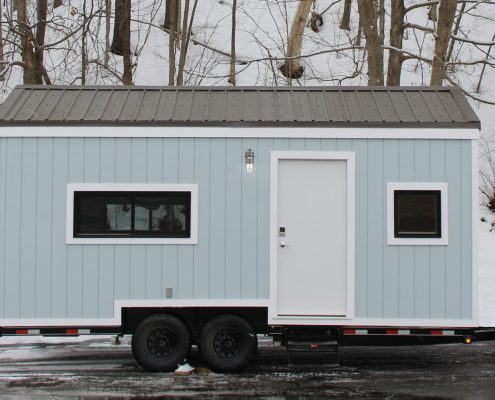
Developers have started investing in tiny house campgrounds and hotels. These sites offer guests a unique way to travel and experience their surroundings. Check out these tiny house hotels across the United States.In addition, tiny house owners can rent out their tiny house on sites like AirBnB when they are not using it. Read our blog post on turning your tiny house into an investment. Tiny houses provide a great business venture for those that wish to embark.
Want to stay up to date on tiny house news? Fill out our form below.
Learn more about our process or fill out the form below and one of our tiny house experts will reach out to you.
